Mass spectrometry
Mass spectrometry (MS) is an analytical technique that is used to measure the mass-to-charge ratio of ions. The results are presented as a mass spectrum, a plot of intensity as a function of the mass-to-charge ratio. Mass spectrometry is used in many different fields and is applied to pure samples as well as complex mixtures.
A mass spectrum is a type of plot of the ion signal as a function of the mass-to-charge ratio. These spectra are used to determine the elemental or isotopic signature of a sample, the masses of particles and of molecules, and to elucidate the chemical identity or structure of molecules and other chemical compounds.
In a typical MS procedure, a sample, which may be solid, liquid, or gaseous, is
History of the mass spectrometer
In 1886,
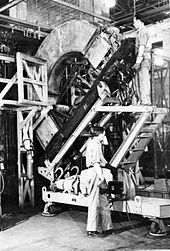
The word spectrograph had become part of the
Modern techniques of mass spectrometry were devised by
In 1989, half of the
In 2002, the
Parts of a mass spectrometer
A mass spectrometer consists of three components: an ion source, a mass analyzer, and a detector. The ionizer converts a portion of the sample into ions. There is a wide variety of ionization techniques, depending on the phase (solid, liquid, gas) of the sample and the efficiency of various ionization mechanisms for the unknown species. An extraction system removes ions from the sample, which are then targeted through the mass analyzer and into the detector. The differences in masses of the fragments allows the mass analyzer to sort the ions by their mass-to-charge ratio. The detector measures the value of an indicator quantity and thus provides data for calculating the abundances of each ion present. Some detectors also give spatial information, e.g., a multichannel plate.
Theoretical example
The following describes the operation of a spectrometer mass analyzer, which is of the
Creating ions
The ion source is the part of the mass spectrometer that ionizes the material under analysis (the analyte). The ions are then transported by magnetic or electric fields to the mass analyzer.
Techniques for ionization have been key to determining what types of samples can be analyzed by mass spectrometry.
Hard ionization and soft ionization
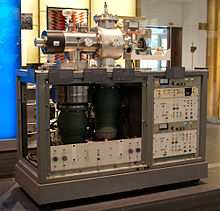
In mass spectrometry, ionization refers to the production of gas phase ions suitable for resolution in the mass analyser or mass filter. Ionization occurs in the
Hard ionization techniques are processes which impart high quantities of residual energy in the subject molecule invoking large degrees of fragmentation (i.e. the systematic rupturing of bonds acts to remove the excess energy, restoring stability to the resulting ion). Resultant ions tend to have m/z lower than the molecular ion (other than in the case of proton transfer and not including isotope peaks). The most common example of hard ionization is electron ionization (EI).
Soft ionization refers to the processes which impart little residual energy onto the subject molecule and as such result in little fragmentation. Examples include fast atom bombardment (FAB), chemical ionization (CI), atmospheric-pressure chemical ionization (APCI), atmospheric-pressure photoionization (APPI), electrospray ionization (ESI), desorption electrospray ionization (DESI), and matrix-assisted laser desorption/ionization (MALDI).
Inductively coupled plasma
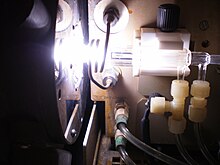
Photoionization mass spectrometry
Ambient ionization
Some applications for
Other ionization techniques
Others include
Mass selection
Mass analyzers separate the ions according to their mass-to-charge ratio. The following two laws govern the dynamics of charged particles in electric and magnetic fields in vacuum:
- (Newton's second lawof motion in the non-relativistic case, i.e. valid only at ion velocity much lower than the speed of light).
Here F is the force applied to the ion, m is the mass of the ion, a is the acceleration, Q is the ion charge, E is the electric field, and v × B is the
Equating the above expressions for the force applied to the ion yields:
This
There are many types of mass analyzers, using either static or dynamic fields, and magnetic or electric fields, but all operate according to the above differential equation. Each analyzer type has its strengths and weaknesses. Many mass spectrometers use two or more mass analyzers for tandem mass spectrometry (MS/MS). In addition to the more common mass analyzers listed below, there are others designed for special situations.
There are several important analyzer characteristics. The
Sector instruments

A sector field mass analyzer uses a static electric and/or magnetic field to affect the path and/or velocity of the charged particles in some way. As shown above,
Time-of-flight
The
Quadrupole mass filter
Quadrupole mass analyzers use oscillating electrical fields to selectively stabilize or destabilize the paths of ions passing through a radio frequency (RF) quadrupole field created between four parallel rods. Only the ions in a certain range of mass/charge ratio are passed through the system at any time, but changes to the potentials on the rods allow a wide range of m/z values to be swept rapidly, either continuously or in a succession of discrete hops. A quadrupole mass analyzer acts as a mass-selective filter and is closely related to the quadrupole ion trap, particularly the linear quadrupole ion trap except that it is designed to pass the untrapped ions rather than collect the trapped ones, and is for that reason referred to as a transmission quadrupole. A magnetically enhanced quadrupole mass analyzer includes the addition of a magnetic field, either applied axially or transversely. This novel type of instrument leads to an additional performance enhancement in terms of resolution and/or sensitivity depending upon the magnitude and orientation of the applied magnetic field.[19][20] A common variation of the transmission quadrupole is the triple quadrupole mass spectrometer. The "triple quad" has three consecutive quadrupole stages, the first acting as a mass filter to transmit a particular incoming ion to the second quadrupole, a collision chamber, wherein that ion can be broken into fragments. The third quadrupole also acts as a mass filter, to transmit a particular fragment ion to the detector. If a quadrupole is made to rapidly and repetitively cycle through a range of mass filter settings, full spectra can be reported. Likewise, a triple quad can be made to perform various scan types characteristic of tandem mass spectrometry.
Ion traps
Three-dimensional quadrupole ion trap
The quadrupole ion trap works on the same physical principles as the quadrupole mass analyzer, but the ions are trapped and sequentially ejected. Ions are trapped in a mainly quadrupole RF field, in a space defined by a ring electrode (usually connected to the main RF potential) between two endcap electrodes (typically connected to DC or auxiliary AC potentials). The sample is ionized either internally (e.g. with an electron or laser beam), or externally, in which case the ions are often introduced through an aperture in an endcap electrode.
There are many mass/charge separation and isolation methods but the most commonly used is the mass instability mode in which the RF potential is ramped so that the orbit of ions with a mass a > b are stable while ions with mass b become unstable and are ejected on the z-axis onto a detector. There are also non-destructive analysis methods.
Ions may also be ejected by the resonance excitation method, whereby a supplemental oscillatory excitation voltage is applied to the endcap electrodes, and the trapping voltage amplitude and/or excitation voltage frequency is varied to bring ions into a resonance condition in order of their mass/charge ratio.[21][22]
Cylindrical ion trap
The
Linear quadrupole ion trap
A
A toroidal ion trap can be visualized as a linear quadrupole curved around and connected at the ends or as a cross-section of a 3D ion trap rotated on edge to form the toroid, donut-shaped trap. The trap can store large volumes of ions by distributing them throughout the ring-like trap structure. This toroidal shaped trap is a configuration that allows the increased miniaturization of an ion trap mass analyzer. Additionally, all ions are stored in the same trapping field and ejected together simplifying detection that can be complicated with array configurations due to variations in detector alignment and machining of the arrays.[24]
As with the toroidal trap, linear traps and 3D quadrupole ion traps are the most commonly miniaturized mass analyzers due to their high sensitivity, tolerance for mTorr pressure, and capabilities for single analyzer tandem mass spectrometry (e.g. product ion scans).[25]
Orbitrap
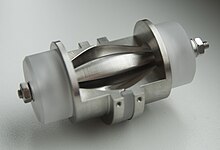
Orbitraps have a high mass accuracy, high sensitivity and a good dynamic range.[26]
Fourier-transform ion cyclotron resonance
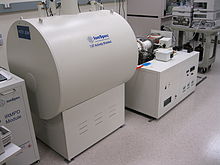
Ion cyclotron resonance (ICR) is an older mass analysis technique similar to FTMS except that ions are detected with a traditional detector. Ions trapped in a Penning trap are excited by an RF electric field until they impact the wall of the trap, where the detector is located. Ions of different mass are resolved according to impact time.
Detectors

The final element of the mass spectrometer is the detector. The detector records either the charge induced or the current produced when an ion passes by or hits a surface. In a scanning instrument, the signal produced in the detector during the course of the scan versus where the instrument is in the scan (at what m/Q) will produce a mass spectrum, a record of ions as a function of m/Q.
Typically, some type of
Tandem mass spectrometry

A
Tandem mass spectrometry enables a variety of experimental sequences. Many commercial mass spectrometers are designed to expedite the execution of such routine sequences as selected reaction monitoring (SRM), precursor ion scanning, product ion scanning, and neutral loss scanning.[32]
- In SRM, the first analyzer allows only a single mass through and the second analyzer monitors for multiple user-defined fragment ions over longer dwell-times than could be achieved in a full scan. This increases sensitivity.
- In product ion scans, the first mass analyzer is fixed to select a particular precursor ion ("parent"), while the second is scanned to find all the fragments ("products", or "daughter ions") to which it can be fragmented in the collision cell.
- In precursor ion scans, the second mass analyzer is fixed to select a particular fragment ion ("daughter"), while the first is scanned to find all possible precursor ions that could give rise to this fragment.
- In neutral loss scans, the two mass analyzers are scanned in parallel, but separated by the mass of a molecular subunit of interest to the analyst. Ions are detected if they lose that fixed mass during fragmentation. This can be used to look for any chemical that is capable of losing a particular neutral group, for example a sugar residue. Together, neutral loss and precursor ion scans can be used to hunt for chemicals with particular motifs.
Another type of tandem mass spectrometry used for radiocarbon dating is accelerator mass spectrometry (AMS), which uses very high voltages, usually in the mega-volt range, to accelerate negative ions into a type of tandem mass spectrometer.
The METLIN Metabolite and Chemical Entity Database[33][34][35][36] is the largest repository of experimental tandem mass spectrometry data acquired from standards. The tandem mass spectrometry data on over 930,000 molecular standards (as of January 2024)[33][36] is provided to facilitate the identification of chemical entities from tandem mass spectrometry experiments.[37] In addition to the identification of known molecules it is also useful for identifying unknowns using its similarity searching/analysis.[38] All tandem mass spectrometry data comes from the experimental analysis of standards at multiple collision energies and in both positive and negative ionization modes.[33]
Common mass spectrometer configurations and techniques
When a specific combination of source, analyzer, and detector becomes conventional in practice, a compound
Certain applications of mass spectrometry have developed monikers that although strictly speaking would seem to refer to a broad application, in practice have come instead to connote a specific or a limited number of instrument configurations. An example of this is isotope-ratio mass spectrometry (IRMS), which refers in practice to the use of a limited number of sector based mass analyzers; this name is used to refer to both the application and the instrument used for the application.
Separation techniques combined with mass spectrometry
An important enhancement to the mass resolving and mass determining capabilities of mass spectrometry is using it in tandem with chromatographic and other separation techniques.
Gas chromatography

A common combination is
Liquid chromatography

Similarly to gas chromatography MS (GC-MS), liquid chromatography-mass spectrometry (LC/MS or LC-MS) separates compounds chromatographically before they are introduced to the ion source and mass spectrometer. It differs from GC-MS in that the mobile phase is liquid, usually a mixture of
Capillary electrophoresis–mass spectrometry
Capillary electrophoresis–mass spectrometry (CE-MS) is a technique that combines the liquid separation process of capillary electrophoresis with mass spectrometry.[41] CE-MS is typically coupled to electrospray ionization.[42]
Ion mobility
Ion mobility spectrometry-mass spectrometry (IMS/MS or IMMS) is a technique where ions are first separated by drift time through some neutral gas under an applied electrical potential gradient before being introduced into a mass spectrometer.
The duty cycle of IMS is short relative to liquid chromatography or gas chromatography separations and can thus be coupled to such techniques, producing triple modalities such as LC/IMS/MS.[45]
Data and analysis

Data representations
Mass spectrometry produces various types of data. The most common data representation is the mass spectrum.
Certain types of mass spectrometry data are best represented as a
Other types of mass spectrometry data are well represented as a three-dimensional
Data analysis
Mass spectrometry data analysis is specific to the type of experiment producing the data. General subdivisions of data are fundamental to understanding any data.
Many mass spectrometers work in either negative ion mode or positive ion mode. It is very important to know whether the observed ions are negatively or positively charged. This is often important in determining the neutral mass but it also indicates something about the nature of the molecules.
Different types of ion source result in different arrays of fragments produced from the original molecules. An electron ionization source produces many fragments and mostly single-charged (1-) radicals (odd number of electrons), whereas an electrospray source usually produces non-radical quasimolecular ions that are frequently multiply charged. Tandem mass spectrometry purposely produces fragment ions post-source and can drastically change the sort of data achieved by an experiment.
Knowledge of the origin of a sample can provide insight into the component molecules of the sample and their fragmentations. A sample from a synthesis/manufacturing process will probably contain impurities chemically related to the target component. A crudely prepared biological sample will probably contain a certain amount of salt, which may form adducts with the analyte molecules in certain analyses.
Results can also depend heavily on sample preparation and how it was run/introduced. An important example is the issue of which matrix is used for MALDI spotting, since much of the energetics of the desorption/ionization event is controlled by the matrix rather than the laser power. Sometimes samples are spiked with sodium or another ion-carrying species to produce adducts rather than a protonated species.
Mass spectrometry can measure molar mass, molecular structure, and sample purity. Each of these questions requires a different experimental procedure; therefore, adequate definition of the experimental goal is a prerequisite for collecting the proper data and successfully interpreting it.
Interpretation of mass spectra

Since the precise
Analysis of mass spectra can also be spectra with
A recent technique for structure elucidation in mass spectrometry, called precursor ion fingerprinting, identifies individual pieces of structural information by conducting a search of the tandem spectra of the molecule under investigation against a library of the product-ion spectra of structurally characterized precursor ions.[48]
Applications
Mass spectrometry has both
As an analytical technique it possesses distinct advantages such as: Increased sensitivity over most other analytical techniques because the analyzer, as a mass-charge filter, reduces background interference, Excellent specificity from characteristic fragmentation patterns to identify unknowns or confirm the presence of suspected compounds, Information about molecular weight, Information about the isotopic abundance of elements, Temporally resolved chemical data.
A few of the disadvantages of the method is that it often fails to distinguish between optical and geometrical isomers and the positions of substituent in o-, m- and p- positions in an aromatic ring. Also, its scope is limited in identifying hydrocarbons that produce similar fragmented ions.
Isotope ratio MS: isotope dating and tracing

Mass spectrometry is also used to determine the
Membrane-introduction mass spectrometry: measuring gases in solution
Membrane-introduction mass spectrometry combines the isotope ratio MS with a reaction chamber/cell separated by a gas-permeable membrane. This method allows the study of gases as they evolve in solution. This method has been extensively used for the study of the production of oxygen by Photosystem II.[52]
Trace gas analysis
Several techniques use ions created in a dedicated ion source injected into a flow tube or a drift tube:
Another technique with applications in trace gas analysis field is secondary electrospray ionization (SESI-MS), which is a variant of electrospray ionization. SESI consist of an electrospray plume of pure acidified solvent that interacts with neutral vapors. Vapor molecules get ionized at atmospheric pressure when charge is transferred from the ions formed in the electrospray to the molecules. One advantage of this approach is that it is compatible with most ESI-MS systems.[53][54]
Residual gas analysis

A
Atom probe
An
Pharmacokinetics
Pharmacokinetics is often studied using mass spectrometry because of the complex nature of the matrix (often blood or urine) and the need for high sensitivity to observe low dose and long time point data. The most common instrumentation used in this application is
There is currently considerable interest in the use of very high sensitivity mass spectrometry for
Recent studies show that secondary electrospray ionization (SESI) is a powerful technique to monitor drug kinetics via breath analysis.[58][59] Because breath is naturally produced, several datapoints can be readily collected. This allows for the number of collected data-points to be greatly increased.[60] In animal studies, this approach SESI can reduce animal sacrifice.[59] In humans, SESI-MS non-invasive analysis of breath can help study the kinetics of drugs at a personalized level.[58][61][62]
Protein characterization
Mass spectrometry is an important method for the characterization and
Space exploration

As a standard method for analysis, mass spectrometers have reached other planets and moons. Two were taken to
Mass spectrometers are also widely used in space missions to measure the composition of plasmas. For example, the Cassini spacecraft carried the Cassini Plasma Spectrometer (CAPS),[67] which measured the mass of ions in Saturn's magnetosphere.
Respired gas monitor
Mass spectrometers were used in hospitals for respiratory gas analysis beginning around 1975 through the end of the century. Some are probably still in use but none are currently being manufactured.[68]
Found mostly in the
The uniqueness of this magnetic sector mass spectrometer may have been the fact that a plane of detectors, each purposely positioned to collect all of the ion species expected to be in the samples, allowed the instrument to simultaneously report all of the gases respired by the patient. Although the mass range was limited to slightly over 120
Preparative mass spectrometry
The primary function of mass spectrometry is as a tool for chemical analyses based on detection and quantification of ions according to their mass-to-charge ratio. However, mass spectrometry also shows promise for material synthesis.[51] Ion soft landing is characterized by deposition of intact species on surfaces at low kinetic energies which precludes the fragmentation of the incident species.[70] The soft landing technique was first reported in 1977 for the reaction of low energy sulfur containing ions on a lead surface.[71]
See also
- Dumas method of molecular weight determination
- Evolved gas analysis
- Helium mass spectrometer
- Isotope dilution
- MassBank (database), a Japanese spectral database
- Mass spectrometry imaging
- Mass spectrometry software
- MasSpec Pen
- Micro-arrays for mass spectrometry
- Nanoscale secondary ion mass spectrometry
- Reflectron
References
- ^ ISBN 978-0-9660813-2-9.
- ^ "Definition of spectrograph[permanent dead link]." Merriam Webster. Accessed 13 June 2008.
- ISBN 978-0-85404-609-6.)
{{cite book}}: CS1 maint: DOI inactive as of April 2024 (link - doi:10.1039/a804629h.
- S2CID 25747367.
- ^ Thomson JJ (1913). Rays Of Positive Electricity and Their Application to Chemical Analysis. London: Longman's Green and Company.
- .
- S2CID 20236081.
- ISSN 0031-9228.
- ^ "The Nobel Prize in Chemistry 2002: Information for the Public". The Nobel Foundation. 9 October 2002. Retrieved 2007-08-29.
- PMID 2675315.
- .
- .
- S2CID 25452748.
- .
- .
- ^ If the ions do not start at identical kinetic energies, then some ions may lag behind higher kinetic energy ions decreasing resolution. Reflectron geometries are commonly employed to correct this problem. Wollnik, H. (1993). "Time-of-flight mass analyzers". Mass Spectrometry Reviews. 12 (2): 89–114. .
- S2CID 9444467. Archived from the original(PDF) on 2018-02-06 – via Google Scholar.
- PMID 24338888.
- S2CID 45734248.
- S2CID 96549388.
- .
- S2CID 26965687.
- S2CID 45444397.
- PMID 26422665.
- PMID 15838939.
- .
- PMID 9768511.
- .
- .
- .
- ^ Busch KL. "A Glossary for Mass Spectrometry" (PDF). Waters.com. Waters. Retrieved 12 February 2024.
- ^ S2CID 221285246.
- S2CID 14774455.
- PMID 29381867.
- ^ ISBN 978-3-031-44256-8, retrieved 2024-03-27
- PMID 38529642.
- PMID 18627180.
- ISBN 0-471-97670-9
- PMID 26434689.
- PMID 2774189.
- PMID 18790125.
- PMID 19498967.
- PMID 11921245.
- S2CID 11531292.
- ISBN 978-0-935702-25-5.
- ^ Mistrik R. "A New Concept for the Interpretation of Mass Spectra Based on a Combination of a Fragmentation Mechanism Database and a Computer Expert System". Highchem.com. Archived from the original on 11 January 2012.
- PMID 19041260.
- ^ Metabolon (2022-01-06). "Solutions to Overcome Limitations of Mass Spectrometry". Metabolon. Retrieved 2022-10-27.
- PMID 22041788.
- ^ .
- PMID 24324477.
- PMID 27859758.
- .
- S2CID 13612670.
- PMID 3789400.
- PMID 3977076.
- ^ PMID 21373707.
- ^ PMID 26015026.
- PMID 28901297.
- PMID 28150005.
- PMID 29767961.
- PMID 28741359.
- S2CID 2676180. – via Annual Reviews (subscription required)
- PMID 17111346.
- PMID 18715800.
- ^ "Cassini Plasma Spectrometer". Southwest Research Institute. Archived from the original on 2018-10-08. Retrieved 2008-01-04.
- S2CID 6334599.
- S2CID 41696370.
- PMID 22900257.
- .
Bibliography
- Tureček F, McLafferty FW (1993). Interpretation of mass spectra. Sausalito, Calif: University Science Books. ISBN 978-0-935702-25-5.
- de Hoffman E, Stroobant V (2001). Mass Spectrometry: Principles and Applications (2nd ed.). John Wiley and Sons. ISBN 978-0-471-48566-7.
- Downard K (2004). Mass Spectrometry – A Foundation Course. Cambridge UK: Royal Society of Chemistry. ISBN 978-0-85404-609-6.
- ISBN 978-0-12-647471-8.
- Dass C (2001). Principles and practice of biological mass spectrometry. New York: John Wiley. ISBN 978-0-471-33053-0.
- Muzikar P, et al. (2003). "Accelerator Mass Spectrometry in Geologic Research". Geological Society of America Bulletin. 115: 643–654. S2CID 55076131.
- Maher S, Jjunju FP, Taylor S (2015). "100 years of mass spectrometry: Perspectives and future trends". Rev. Mod. Phys. 87 (1): 113–135. .
- Sobott F (2014). Biological Mass Spectrometry. Boca Raton: Crc Pr I Llc. ISBN 978-1-4398-9527-6.
- Sparkman OD (2006). Mass Spectrometry Desk Reference. Pittsburgh: Global View Pub. ISBN 978-0-9660813-9-8.
- Watson JT, Sparkman OD (2007). Introduction to Mass Spectrometry: Instrumentatio, Applications, and Strategies for Data Interpretation (4th ed.). Chichester: Jonh Wiley & Sons. ISBN 978-0-470-51634-8.
- Tuniz C (1998). Accelerator mass spectrometry: ultrasensitive analysis for global science. Boca Raton: CRC Press. ISBN 978-0-8493-4538-8.
- Kandiah M, Urban PL (June 2013). "Advances in ultrasensitive mass spectrometry of organic molecules". Chemical Society Reviews. 42 (12): 5299–322. PMID 23471277.
- Calmes J (2011). Mass spec : the biography of a scientific instrument (MS). Massachusetts Instite of Technology. hdl:1721.1/68473.
External links
- Mass Spectrometry at Curlie
- Interactive tutorial on mass spectra National High Magnetic Field Laboratory
- Mass spectrometer simulation An interactive application simulating the console of a mass spectrometer
- Realtime Mass Spectra simulation Tool to simulate mass spectra in the browser





